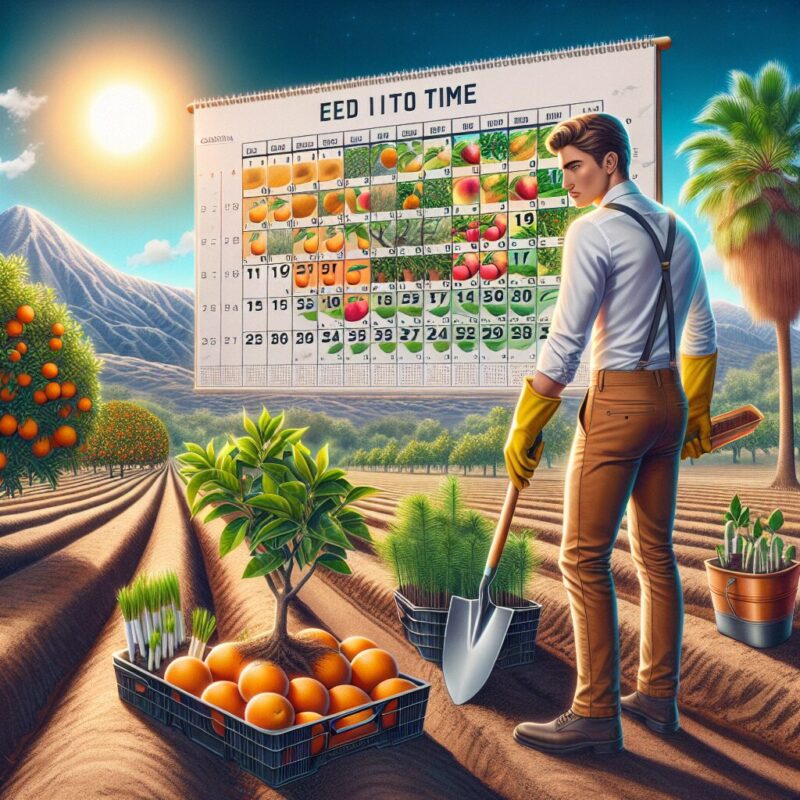When To Plant Fruit Trees In California, the timing can greatly impact the success and yield of your fruit trees. California is known for its diverse climate, ranging from the cool coastal regions to the hot and dry inland areas. Understanding the specific conditions and timing for planting fruit trees in California can ensure optimal growth and bountiful harvests.
One unique fact about planting fruit trees in California is that the state offers a variety of microclimates, each with its own specific conditions. For example, the coastal regions enjoy mild winters and moderate temperatures, making them suitable for a wide range of fruit tree varieties. In contrast, the central valley experiences hot and dry summers but cold winters, requiring fruit trees that can tolerate both extremes. In the higher elevations of the Sierra Nevada, fruit trees must be chosen carefully due to the shorter growing season and colder temperatures. The diverse climates in California make it essential to consider the specific location when deciding when to plant fruit trees.
Moving forward, let’s explore the key takeaways for planting fruit trees in California. We will discuss the ideal planting time for different fruit tree varieties, the importance of considering microclimates, and essential factors to consider when timing your planting. By the end of this article, you will have a comprehensive understanding of when to plant fruit trees in California, ensuring successful growth and fruitful harvests.
Key Takeaways
1. Choose the right time to plant fruit trees in California according to the specific USDA hardiness zone of your location. Zones 9 through 11 have mild winters, making them suitable for year-round planting options. Zones 8 or lower, however, should stick to late winter or early spring planting for optimal growth.
2. Planting fruit trees during the dormant season, usually in late winter or early spring, allows them to establish a strong root system before the heat of summer hits. This helps them cope better with the stress of extreme temperatures and drought conditions in California.
3. Consider the specific needs of different fruit tree varieties. For example, deciduous fruit trees like apples, peaches, and plums require a certain amount of winter chill hours to break dormancy and produce fruit. Mediterranean fruit trees like citrus and avocado prefer frost-free locations and do not require chill hours.
4. Ensure adequate spacing between fruit trees when planting to allow for proper air circulation and sunlight exposure. This helps prevent the spread of diseases and ensures healthy growth and fruit production. Consulting a spacing guide specific to each fruit tree variety is recommended.
5. Carefully prepare the planting area by ensuring proper soil drainage, removing weeds, and amending the soil with organic matter. Good soil preparation contributes to successful establishment and growth of fruit trees. Regular watering, mulching, and timely pruning are important maintenance practices to promote healthy tree development and fruitful harvests.
When is the Best Time to Plant Fruit Trees in California?
Choosing the Right Time
Planting fruit trees in California requires careful consideration of the climate and specific regions within the state. While California is known for its Mediterranean climate, the diverse microclimates throughout the state affect the ideal timing for planting fruit trees. To determine the best time, factors such as temperature, rainfall, frost dates, and the type of fruit tree must all be taken into account.
Deciduous vs. Evergreen Fruit Trees
It’s essential to understand the difference between deciduous and evergreen fruit trees and their specific planting requirements. Deciduous trees shed their leaves during the winter and go dormant, while evergreen trees retain their leaves year-round. Deciduous fruit trees are typically planted in the dormant season, while evergreen fruit trees have more flexibility in terms of planting time.
Dormant Season Planting
The dormant season, which generally occurs from late fall to early spring, is generally the preferred time to plant deciduous fruit trees in California. This period allows the roots to establish before the tree begins to bud in spring. However, it is important to avoid planting during periods of freezing temperatures, as it may damage the tree. Check local frost dates and opt for planting when there is minimal risk of frost.
Evergreen Fruit Tree Planting
Evergreen fruit trees, such as citrus trees, have more flexibility in planting time due to their ability to adapt to different conditions. While they can be planted throughout the year, it is still recommended to avoid extreme weather conditions. Planting in early spring allows the tree to establish itself before facing the hot summer months. However, if mild winters are experienced in your region, planting in fall can also be suitable for evergreen fruit trees.
Consider Local Microclimates
California’s diverse microclimates mean that the optimal planting time can vary from region to region. Coastal areas, for example, have milder temperatures and face fewer freeze risks, allowing for more extended planting windows. Inland and mountainous regions, on the other hand, may experience harsher winters and require more careful timing. Researching and understanding your specific location’s microclimate will help you choose the best time to plant your fruit trees.
Additional Considerations
When planting fruit trees in California, consider a few more factors to ensure successful growth:
- Soil Preparation: Prior to planting, make sure the soil is well-drained and has adequate organic matter. Improving soil conditions will provide a healthy foundation for your fruit trees.
- Watering: Newly planted trees require regular watering to establish roots. Provide sufficient water without overwatering, ensuring the soil remains moist but not waterlogged.
- Sunlight Exposure: Fruit trees thrive in full sunlight. Ensure that your planting location receives at least 6-8 hours of direct sunlight daily for optimum growth and fruit production.
- Pruning: Prune your fruit trees during their dormant period. This helps shape the tree, improve air circulation, and remove dead or diseased branches.
- Pest and Disease Management: Implement appropriate pest and disease control measures to protect your fruit trees from common threats in your area. Regular inspection and early intervention are crucial for tree health.
Conclusion
Knowing the best time to plant fruit trees in California is vital for their successful growth and productivity. Considering factors such as the type of fruit tree, local microclimates, and following proper planting and maintenance practices will help ensure your fruit trees thrive in the California climate. Enjoy the bountiful harvests that these trees will provide for years to come!
Frequently Asked Questions
1. Can fruit trees be planted in California year-round?
No, fruit trees in California should be planted during specific times of the year. Timing is crucial to ensure the tree’s successful establishment and growth.
2. What is the ideal time of year to plant fruit trees in California?
The best time to plant fruit trees in California is during the dormant season, which typically falls between late fall and early spring. This period allows the tree to settle in and develop its root system before the growing season begins.
3. Should I consider the climate of my specific region when planting fruit trees in California?
Absolutely! California has a diverse climate, ranging from temperate coastal areas to arid and hot inland regions. It’s essential to consider your region’s climate and choose fruit tree varieties that are suitable for your specific conditions.
4. Can I plant fruit trees in containers in California?
Yes, you can! Container planting is a great option for those with limited space or unfavorable soil conditions. However, it’s important to select suitable containers, provide proper drainage, and choose dwarf or semi-dwarf fruit tree varieties that are well-suited for container growth.
5. Are there any specific soil requirements for planting fruit trees in California?
Yes, the soil should be well-drained and rich in organic matter. Conduct a soil test to determine its nutrient content and pH levels. Adjustments can be made by amending the soil with compost, peat moss, or other organic materials to create an optimal growing environment for the trees.
6. Can I plant bare-root fruit trees in California?
Definitely! Bare-root fruit trees are a cost-effective and popular choice among gardeners. They are typically available during the dormant season and have well-developed root systems. Planting bare-root trees in California is an excellent option, but ensure they are planted promptly upon purchase.
7. How much sunlight do fruit trees in California require?
Fruit trees generally need at least 6 hours of direct sunlight daily to thrive. However, different fruit tree varieties have varying sunlight requirements, so it’s advisable to check the specific needs of the tree you intend to plant.
8. Can I use mulch around my newly planted fruit trees in California?
Absolutely! Mulching around newly planted fruit trees helps conserve moisture, suppresses weed growth, and maintains a stable soil temperature. Ensure the mulch is applied a few inches away from the tree trunk and spread evenly around the tree’s drip line.
9. Are there any special care instructions I should follow after planting fruit trees in California?
Indeed! After planting, it’s crucial to water the tree regularly, especially during the first year, to facilitate root establishment. Provide proper fertilization based on soil test recommendations and prune the tree as necessary. Monitoring pests, diseases, and overall tree health is also important to ensure optimal growth.
10. How long does it take for fruit trees in California to bear fruit?
The time it takes for a fruit tree to bear fruit in California varies depending on the tree species and variety. On average, many fruit trees start producing fruit between 2 to 5 years after planting, but it can take longer for some types.
Final Thoughts
Considering the appropriate timing to plant fruit trees in California is vital for a successful harvest. By planting during the dormant season, you give your trees a head start, allowing them to establish a strong root system before facing the challenges of the growing season.
Remember to select fruit tree varieties that are well-suited for your region’s climate and soil conditions. Proper care, including regular watering, fertilization, and vigilance against pests and diseases, will ensure your fruit trees thrive and provide you with a bountiful harvest for years to come.

